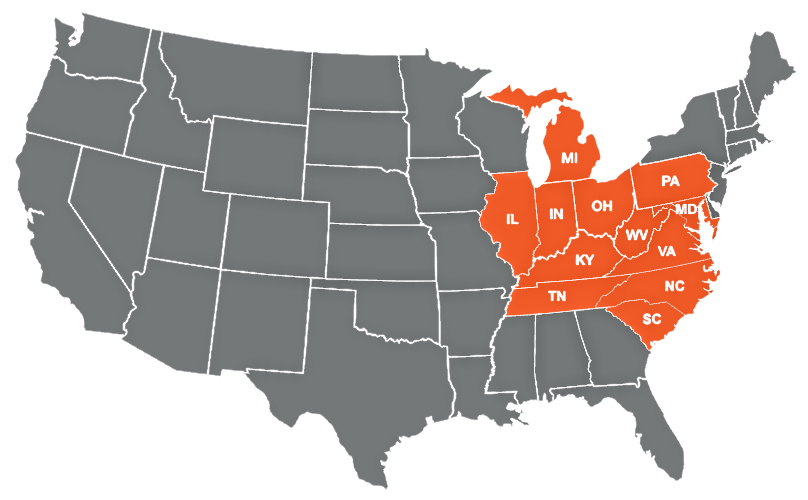Sandstone is appreciated worldwide for its diverse natural elegance and timeless beauty. But what truly makes this sedimentary rock special is its captivating range of colors – from subtle greys to rich reds. Sandstone’s palette is nature’s artistry playing out through minerals, textures and changing light. Cornerstone Crushing, known for their expertise in providing high-quality sandstone, brings this natural wonder right to your doorstep, enhancing the beauty of spaces with its vibrant hues and textures.
Decoding sandstone’s colors is a journey into geology, architecture and design. It reveals stories of the earth’s forces, cultural identities, emotions, and creative visions.
Join us as we explore the vibrant factors behind sandstone’s colors and how they bring spaces to life.
How Sandstone’s Colors Come to Be
Sandstone starts forming when grains of quartz, feldspar, and other minerals fuse with natural cements. As this blend solidifies over centuries, a palette of tones emerges based on:
Mineral Composition
- Quartz brings light tans and buffs
- Iron oxides create rusty reds
- Manganese oxides lead to violet hues
- Clays form blue and grey tones
Changing ratios of these minerals colors sandstone everything from white to black.
Oxidation Magic
When iron binds with oxygen, it transforms to a reddish pigment called hematite. Increased oxidation leads to richer reds. Think of it as “mineral rust”.
Surface Staining
During sandstone’s formation, mineral-rich waters seep through tiny pores, leaving their mark on the rock. These stains contribute undertones of yellow, red and brown.
Surrounding Sediments
Sandstone can be tinted by nearby sediments as well. Proximity to soils with high iron or manganese passes on hints of red and purple respectively.
This interplay of minerals, oxidation and staining creates sandstone’s one-of-a-kind color variations. Now let’s explore some of its most popular palettes.
Prominent Sandstone Color Varieties
From elegant greys to multi-colored blends, sandstone offers tones for every architectural vision.
Elegant Greys
Subtle greys project an air of refined sophistication. When used in structures, walkways or accent walls, grey sandstone blends serenely with surroundings while allowing other features to shine.
Its cool and harmonious energy also extends beautifully into interiors through fireplace mantels, kitchen backsplashes and concrete-like flooring.
Warming Buffs
Buff sandstone beams with gorgeous golden undertones reminiscent of sunrays through desert canyons. Its earthy radiance enhances natural landscapes from courtyards to vineyards.
Buff colors also cultivate an inviting mood for living spaces. Think cozy outdoor lounging nooks, rustic kitchen tables or bedroom feature walls. This sandstone variety seamlessly bridges indoor and outdoor atmospheres.
Timeless Tans
Sandstone in lighter tan and brown hues exude a familiar, nostalgic charm. These friendly tones make tanned sandstone extremely versatile in creating traditional outdoor living spaces.
Courtyards, garden paths and patios glow invitingly when rendered in tan. Its flexibility also enables contemporary uses like earthy facade details or neutral backdrops for greenery. Tanned sandstone is a timeless architectural choice.
Vibrant Reds
Red is the showstopper color in sandstone. From burnt orange to crimson, sandstone’s red varieties astound with their saturated hues. These bold accents magnetically draw the eye, creating focal points in gardens and structures.
Imagine red sandstone swimming pool copings, retaining walls or water features enlivening your lawn. Indoors, red adds power to fireplaces, kitchen islands, tile floor medallions and staircases. Wherever applied, vibrant red sandstone energizes spaces thrillingly.
Harmonious Greens
While less common, sandstone also manifests in olive green, sage and mossy tones. These earthy greens connect deeply with natural settings like garden walls, wooded pathways or pastoral patio landscapes.
Applied thoughtfully in indoor environments as well, green sandstone recalls the outdoors through living walls, plant-adjoining accents and grounding design motifs. Its harmonizing energy calms and rejuvenates.
Captivating Multicolors
Some sandstone formations reveal wondrous multicolored banding, swirls and mottling reminiscent of artisan textiles or painterly abstracts. These rare varieties add incredible visual richness and inspiration for one-of-a-kind designs.
Color-woven sandstone brings uniqueness to facades, landscape sculptures, aquatic features and indoor installations. Applied thoughtfully, they become jewelry for architecture.
Sandstone’s Shifting Colors
Beyond its mineral-influenced palette, sandstone also transforms under different lighting. Sunrays and shadows bring out striking variations adding allure through the days and seasons.
Morning light warms up undertones, midday brightens them fully, while dusk softens sandstone into further elegance.
These color changes keep spaces engaging over time. Thoughtful lighting design can also accentuate favored hues. Understand how light falls across your sandstone installation for maximum enjoyment.
Cultural Stories Written in Stone
The colors of sandstone hold deep cultural meaning and connect us with history. Architectural icons from India’s Red Fort to England’s York Minster draw identity from the regional sandstone shaping them.
Majestic red sandstone epitomizes regal Indian structures while English coastal villages adopt local grey, buff and tan varieties. Sandstone color preferences tell tales of customs, environments, and eras memorialized in stone.
Bringing this into contemporary designs adds meaningful context. Whether complementing heritage buildings or echoing cultural style, sandstone’s colors write new stories honoring the past.
Unlocking Design Possibilities
Sandstone’s versatile palette now gives you a rich material vocabulary for interior, exterior and landscape designs.
Play with color contrasts by juxtaposing grey paving against red garden walls or tan kitchen cabinetry against vibrant backsplashes.
Harmonize tones for cohesive beauty as in all-white villas or buff patios dissolving into desert garden schemes.
Create focal points with sandstone fireplaces, stately front entrances or striking water features in red.
Finally, express your unique vision through color choices reflecting style sensibilities from Mediterranean warmth to contemporary elegance.
The combinations are endless. Sandstone’s captivating hues now empower truly custom spaces speaking your design language.
FAQs on Sandstone Colors
What causes different sandstone colors?
Sandstone colors originate from mineral composition, oxidation, surface staining and surrounding sediment impacts during formation.
Can sandstone change color over time?
Yes. Environmental factors like sun exposure and oxidation slowly alter sandstone’s colors across decades lending patinas.
Is colored sandstone more expensive?
Yes, certain rare or imported varieties like rich red Australian sandstone cost more than common regional types.
What is the most popular sandstone color?
In the USA, tan and light brown hues are the most popular for their versatility. Internationally red and buff sandstones dominate.
Which sandstone color is best for patios?
Tans and buffs complement most patio landscapes and schemes beautifully at affordable prices.
We hope unlocking sandstone’s vibrant color stories has inspired your architectural dreams with new possibilities. Whether subtly elegant or dramatically bold, sandstone’s visual energy is waiting to transform spaces.


